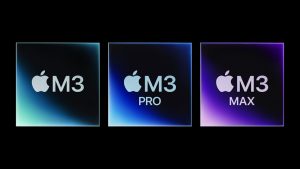24
Nov
Unveiling the Future- with Apple
In a groundbreaking announcement, Apple has unleashed its latest marvels upon the tech world – the M3, M3 Pro, and M3 Max chips. Representing a significant leap in personal computer chip technology, these three processors are the pioneers in utilizing the cutting-edge 3-nanometer process, signaling a new era of efficiency and performance for Mac users.
The Evolution of Apple Silicon
Apple's foray into silicon technology has been nothing short of revolutionary. The M3 family of chips builds on the success of its predecessor, the M1, showcasing the relentless pursuit of innovation in the world of personal computing. Johny Srouji, Apple’s senior vice president of Hardware Technologies, emphasizes the transformative impact of Apple silicon on the Mac experience, stating, "Every aspect of its architecture is designed for performance and power efficiency."Harnessing Internal Strength: Cutting-Edge GPU Architecture
At the heart of the M3 family lies a next-generation GPU, marking the most significant leap in graphics architecture for Apple silicon. Dynamic Caching, a groundbreaking technology, allows real-time allocation of local memory, optimizing performance for demanding applications and games. This innovative approach results in rendering speeds up to 2.5 times faster than the M1 family of chips. One of the most exciting features introduced with the M3 is hardware-accelerated ray tracing. Bringing this capability to the Mac for the first time, ray tracing enables the creation of extremely realistic and physically accurate images by modeling the interaction of light with a scene. Game developers, in particular, stand to benefit from more accurate shadows and reflections, enhancing the immersive quality of their creations. Additionally, the M3 GPU introduces hardware-accelerated mesh shading, elevating the efficiency of geometry processing and enabling visually complex scenes in games and graphics-intensive applications. Remarkably, these enhancements come with maintained power efficiency, with the M3 GPU delivering the same performance as the M1 while using nearly half the power and achieving up to 65 percent more peak performance.Specialized engines for AI and video processing.
The M3, M3 Pro, and M3 Max chips boast an enhanced Neural Engine, accelerating machine learning models by up to 60 percent compared to the M1 family of chips. This significant improvement translates to faster AI and machine learning workflows while ensuring data privacy by keeping computations on the device. The advanced media engine in the M3 family provides hardware acceleration for popular video codecs such as H.264, HEVC, ProRes, and ProRes RAW. Notably, the inclusion of AV1 decoding support for the first time enhances power-efficient playback of streaming services, contributing to extended battery life.Unrivaled CPU Performance
The M3 family's next-generation CPU is no slouch either, featuring architectural improvements to both performance and efficiency cores. The performance cores boast a 30 percent increase in speed compared to the M1, enhancing tasks like code compilation and audio processing in applications like Xcode and Logic Pro, respectively. Efficiency cores, on the other hand, exhibit a remarkable 50 percent increase in speed, contributing to faster everyday tasks and optimized battery life. This harmonious balance results in a CPU that matches the multithreaded performance of the M1 while utilizing as little as half the power and delivering up to 35 percent more peak performance.Unified Memory Architecture: Up to 128GB of Power
A hallmark of Apple silicon, the M3 family introduces a unified memory architecture that enhances bandwidth, reduces latency, and optimizes power efficiency. With a single pool of memory accessible to all chip technologies, data transfer between multiple memory pools is eliminated, significantly improving overall system performance and efficiency. The support for up to 128GB of memory is a game-changer, unlocking new possibilities for users, especially in fields such as AI development where larger transformer models with billions of parameters can now be accommodated seamlessly. This move towards higher memory capacity demonstrates Apple's commitment to meeting the evolving needs of users engaged in resource-intensive tasks.Introducing the M3, M3 Pro, and M3 Max
M3: Outstanding performance tailored for widely used systems.
The M3 chip, with its 25 billion transistors, represents a substantial upgrade over its predecessor, the M2, with an additional 5 billion transistors. Featuring a 10-core GPU that is 65 percent faster than the M1 for graphics performance, the M3 is poised to deliver an unparalleled experience for users engaging in graphics-intensive tasks. The 8-core CPU, with four performance cores and four efficiency cores, is up to 35 percent faster than the M1, coupled with support for up to 24GB of unified memory.M3 Pro: Designed for individuals requiring heightened performance levels
Stepping up the game, the M3 Pro is a powerhouse with 37 billion transistors and an 18-core GPU that outshines the M1 Pro by 40 percent. With support for up to 36GB of unified memory, larger projects can be tackled seamlessly on the go. The 12-core CPU, featuring six performance cores and six efficiency cores, offers single-threaded performance up to 30 percent faster than the M1 Pro, making resource-intensive tasks like photo editing in Adobe Photoshop a breeze.M3 Max: A significant advancement in performance for highly challenging professional tasks.
At the pinnacle of the M3 family, the M3 Max boasts an impressive 92 billion transistors, pushing pro performance to new heights. The 40-core GPU, up to 50 percent faster than the M1 Max, coupled with support for up to 128GB of unified memory, opens up possibilities for AI developers working with massive transformer models. The 16-core CPU, with 12 performance cores and four efficiency cores, achieves an astonishing 80 percent increase in performance compared to the M1 Max. Equipped with two ProRes engines, the M3 Max ensures fast and fluid video post-production, catering to the needs of professionals using software like DaVinci Resolve, Adobe Premiere Pro, or Final Cut Pro.Efficiency Meets Sustainability
Beyond sheer performance, Apple remains committed to environmental sustainability. The power-efficient design of the M3, M3 Pro, and M3 Max contributes to the new MacBook Pro achieving its longest battery life ever – up to 22 hours. This not only reduces the need for frequent charging but also aligns with Apple's broader goal of achieving net-zero climate impact across its entire business by 2030. In conclusion, the introduction of the M3 family of chips marks a significant milestone in the evolution of personal computer technology. Apple's relentless pursuit of innovation, coupled with a commitment to sustainability, ensures that users can experience unprecedented levels of performance while minimizing their environmental footprint. As we step into the era of 3-nanometer chips, the M3, M3 Pro, and M3 Max stand as testament to Apple's dedication to redefining the boundaries of what is possible in the world of personal computing.Share this post
RELATED
Posts
Type of Wireless Attacks
Wireless networks have become an integral part of modern connectivity, offering convenience and flexibility. However, they also present vulnerabilities that cyber attackers...
read more
iPhone 15 Pro vs Pro Max: A Sustainable Choice for Tech Enthusiasts
Introduction:
In the ever-evolving world of smartphones, Apple continues to set new standards with its groundbreaking technology and innovation. The iPhone 15 Pro,...
read more
"5 Crucial Tips to Know Before Buying a Refurbished iPhone
In the world of smartphones, iPhones stand as a coveted choice, blending sophistication, functionality, and reliability. However, the hefty price tag often...
read more




